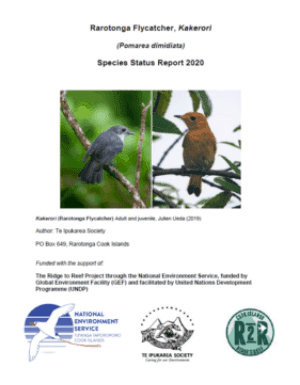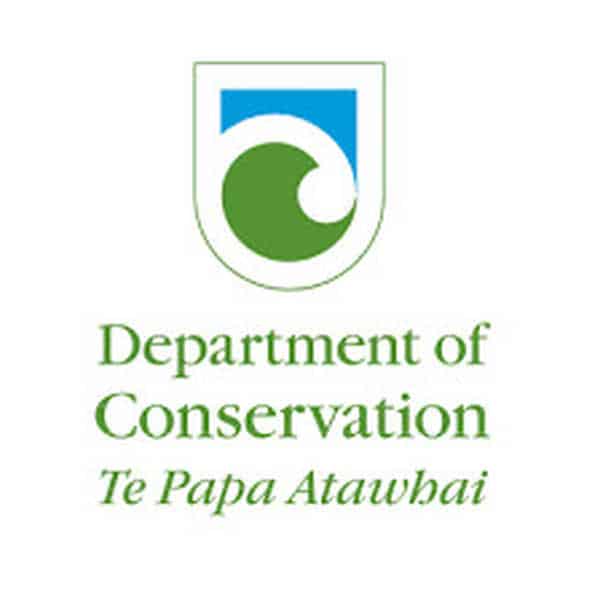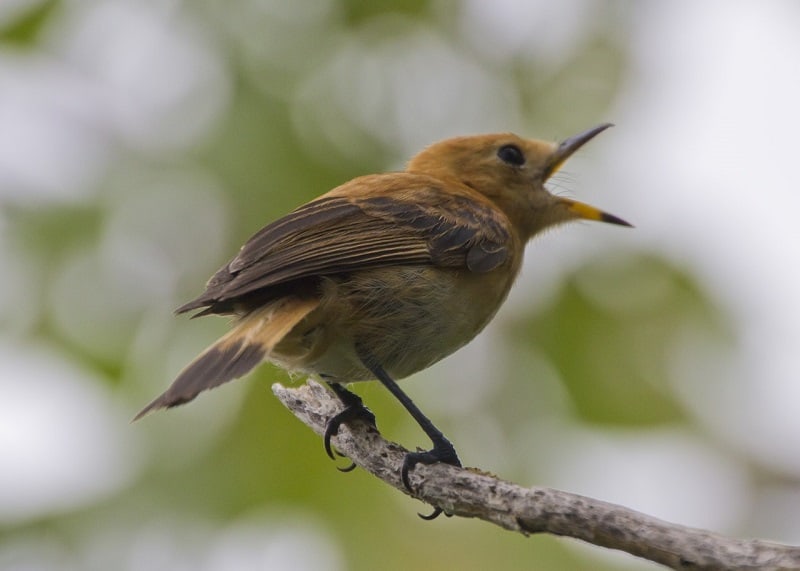
Kākerōri Call
Kākerōri Singing
- General Information
COMMON NAMES:
Rarotonga Flycatcher, Rarotonga Monarch [in American literature, Rarotonga Flycatcher is used in NZ references.] German Rarotongamonarch
TRADITIONAL NAMES:
Kākerōri (RR)
GLOBAL DISTRIBUTION:
NATIVE Cook Islands (Rarotonga) and introduced in Atiu
COOK ISLANDS STATUS:
Native, Resident Breeder, Endemic of Cooks; S.Group only (RR only – rare); Land, mountains
SIGNIFICANCE LIST:
Globally endangered (seriously)
- Introduction
The Kākerōri (Pomarea dimidiata), also known as the Rarotonga monarch or Rarotonga flycatcher, is a species of bird in the Eastern Polynesia Monarch family (Monarchidae). It is endemic to Rarotonga, Cook Islands.
Kākerōri are small perching birds, averaging 22 grams at maturity and feed primarily on small insects in the Rarotonga montane forest. They were very common on Rarotonga in the mid-1880’s, including on the coastal plain; however, within 50 years, their numbers began to decline rapidly and their range became increasingly restricted to the inland forest. A few specimens were collected in the early 1900’s for museums and then the Kākerōri was not seen again, presumed extinct. In 1973, renown ornithologist, David Holyoak discovered a small population of birds in the hills of southern Rarotonga. This area and parts of the surrounding Tōtoko’itu, Tūroa and Avanā valleys became the site of the Takitumu Conservation Area where restoration efforts are focused on bringing the Kākerōri back from the brink of extinction.
- Description
An unusual bird, Both males and females undergo the same set of colour changes as they grow older: all yearlings are orange, with a yellow base to the dark bill; all 2-year-olds are orange, with completely dark bills; 3-year-olds are a variable ‘mixed’ colour, ranging from some females that are blotchy grey and orange, through to some males that are mainly grey but with a variable amount of orange feathering especially on the tail, upper back and wing coverts and about 10% of males appear entirely grey in the field; all birds 4 or more years old are entirely grey.
- Behaviour
Although yearlings of both sexes bred successfully when the population was very small, nowadays most yearlings and 2-year-old Kākerōri form loose flocks on the ridge tops, away from occupied territories in the valleys, although sometimes a young bird may join breeding pairs to help defend territories and raise young.
Territories are mainly in the valleys, sheltered from the prevailing southeast trade winds. Adults are highly territorial and will remain in their territory all year round. They breed from October to February, though most eggs are laid in October and early November. Kākerōri lay 1-2 eggs in a relatively large nest, often placed on the forked branch overhanging a stream. Replacement clutches are often laid, if a nest fails, but only 4% of Kākerōri pairs re-nest after successfully fledging young.
The main cause of nest failures was predation by Ship Rats (Rattus rattus) and/or Kiore/Polynesian Rat (Rattus exulans), with a suspicion that Karavia/Long-tailed Cuckoos (Eudynamys taitensis) prey on some eggs and nestlings. Although present deep in the forest, there is no evidence that Manu Kavamani/Common myna prey on Kākerōri eggs or nestlings. Female survival is lower than that of males because females incubate at night and so are vulnerable to rat predation, but the oldest colour-banded bird was a female which reached a minimum age of 24 years and 8 months.
- Color Change of the Kākerōri
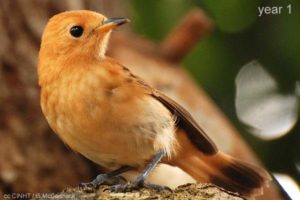
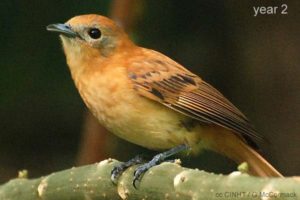
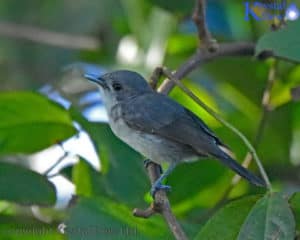
- Kākerōri and its Extended family
Monarchidae
The Monarch family includes over 100 different species split across 2 subfamilies: Terpsiphoninae (Paradise Flycatchers) & Monarchinae (Monarchs). The majority of the family occur across the southern hemisphere from sub-saharan Africa, south-east Asia, Australasia and several Pacific Islands. Generally, the Monarch family includes mostly slim-build, tree living birds with broad bills. Monarchs are typically insect feeding and get their prey in 2 ways: gleaning them from branches and leaves; and catching them in mid-air, using a method known as flycatching. Flycatching is the art of catching insects in the air, usually with the bill. Flycatching is a strenuous activity with high energy demands, as such, the energy reward from a catch-attempt must exceed the energy used to catch prey, given this, Monarchs often hunt medium-sized flying insects such as flies, bees and butterflies. Manoeuvrability, especially when chasing prey in amongst the forest branches and leaves requires an agile bird, the slim-build and short rounded wings of a Monarch are adaptations to improve manoeuvrability. The broad bill of a Monarch is another adaptation to assist these birds in securing their prey, in the case of the Kākerōri, they also have fine whisker-like hairs (rictal bristles) around the bill that may help them sense prey or protect the eyes, scientists are still not sure!
Pomarea
The closest relatives of the Kākerōri belong to the genus Pomarea, named after Pomare, King of Tahiti, Mo’orea and its dependencies, and they are only found on Rarotonga and the high, forested volcanic islands of the Society and Marquesas Islands of French Polynesia. Today, we recognise 6 living species of Pomarea and 3 extinct species.
Molecular analyses suggest that the Tahiti and Rarotonga Monarchs represent the oldest line in the genus with the Marquesan species representing 3 distinct younger lines i.e., Eiao, Nuku Hiva and Ua Huka Monarchs evolving 3.6 million years ago; Ua Pou and Fatu Hiva Monarchs evolving 2.5 million years ago and the Marquesas Monarch being the youngest line, evolving 1.6 million years ago.
The genus is highly threatened, with half of the remaining 6 species listed as critically endangered, 1 endangered and 2 vulnerable. The principal threats to these birds are the introduced ship rat (Rattus rattus) and habitat loss.
- Global Conservation Status
IUCN Listing: | Vulnerable |
- Scientific Classification
Kingdom: | Animalia |
Phylum: | Chordata |
Class: | Aves |
Order: | Passeriformes |
Family: | Monarchidae |
Genus: | Pomarea |
Species: | P. dimidiata |
- Binomial name
Pomarea dimidiata |
(Hartlaub & Finsch, 1871) |
- Cook Island Name
Kākerōri
- English Name
Rarotonga Monarch or Rarotonga Flycatcher
- Find out More about Cook Islands Wildlife by Visiting the Cook Islands National Heritage Trust FB page
- Gallery
- Species Status Report 2020



